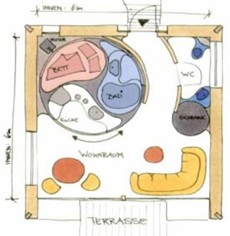 Has any architectural innovation been as unfairly maligned as the revolving restaurant? Call such establishments as the Restaurant Skyline Mannheim and Yanggakdo Hotel kitsch if you must, but we rather like the idea of spinning around while feasting on serviceable victuals. Think of it as a sub-gourmet celebration of man’s aptitude for making grand machines.
Has any architectural innovation been as unfairly maligned as the revolving restaurant? Call such establishments as the Restaurant Skyline Mannheim and Yanggakdo Hotel kitsch if you must, but we rather like the idea of spinning around while feasting on serviceable victuals. Think of it as a sub-gourmet celebration of man’s aptitude for making grand machines.
So imagine our pleasure upon discovering that our species has actually flirted with the idea of bringing revolving restaurant technology into the modern home. As detailed in Chad Randl’s Revolving Architecture: A History of Buildings That Rotate, Swivel, and Pivot, the German industrial designer Luigi Colani played with the idea quite seriously a few years back:
In the early 1980s, Colani developed a plan for a high-density urban development called BioCity. Assuming the shape of a supine human body, its concentrated center resembled the head and torso, with more narrow residential districts extending outward across the landscapes like arms and legs. Each of the BioCity’s limbs was to feature a pair of opposing terraces extending up the banks of a central waterway and populated with over 15,000 individual homes. Intended for construction near Asia’s megacities, the individual BioCity houses were designed to derive the maximum amount of usable space from an extremely small footprint. The interior consisted of a primary room with a turntable divided into three sections, each with furnishings and appliances corresponding to a different room function…
Only one of the turntable’s three sections was accessible at a time. The section in use opened onto the primary room with its large glass wall and narrow partitioned toilet and storage space in the back corner. With the turntable rotated to open a particular section to the primary room, that space was effortlessly adapted to a variety of uses depending on the time of day and the needs of the occupant. “Why lose valuable space through halls and corridors when all the rooms you need can be built back-to-back and attainable at the touch of a button?” the designer asked.
Alas, the great era of planned cities seems to have passed us by, so it’s highly unlikely that some government will ever hire Colani to implement his scheme. How we wish he’d been in the running to help build Brasilia.


Like gas stations in rural Texas after 10 pm, comments are closed.